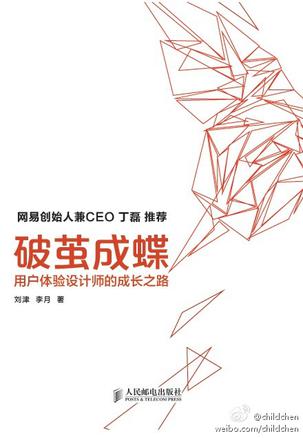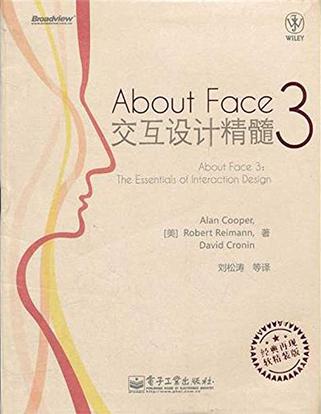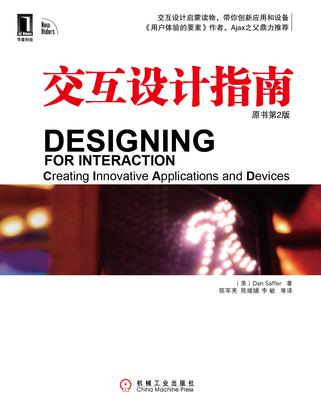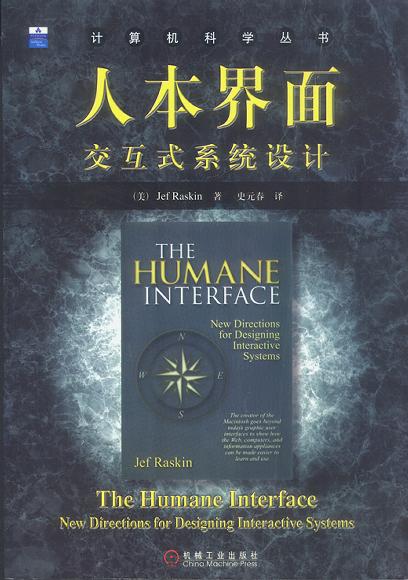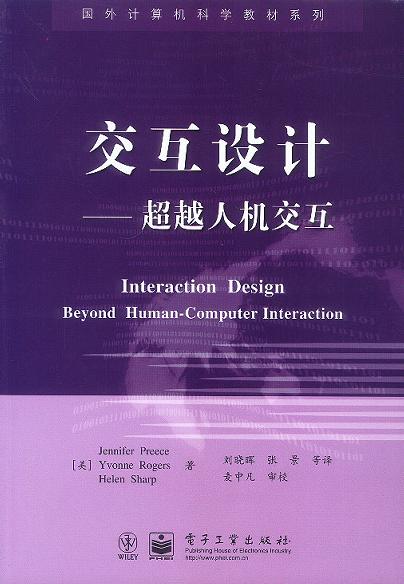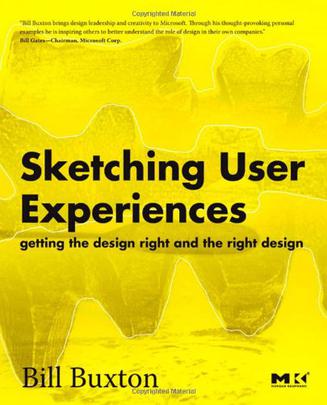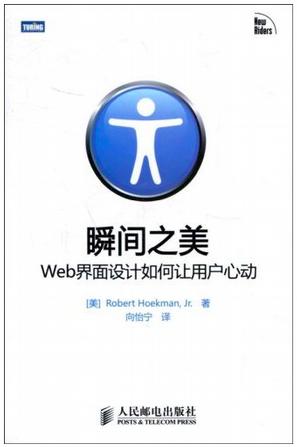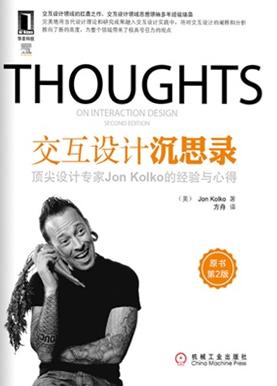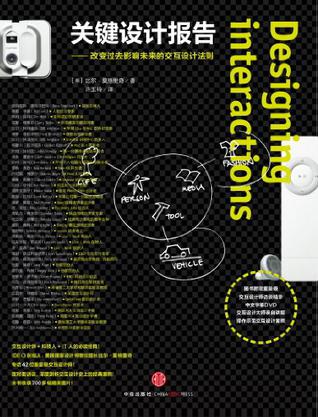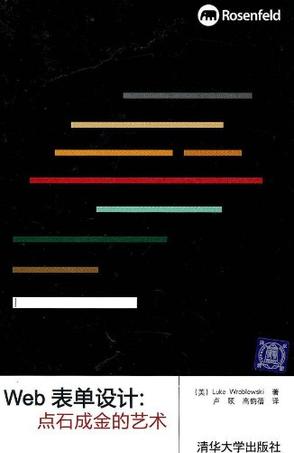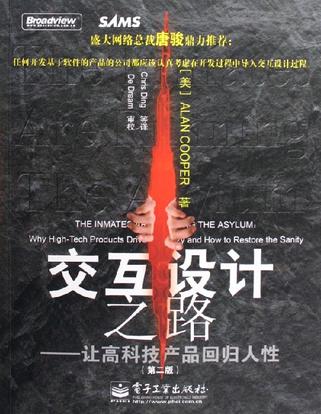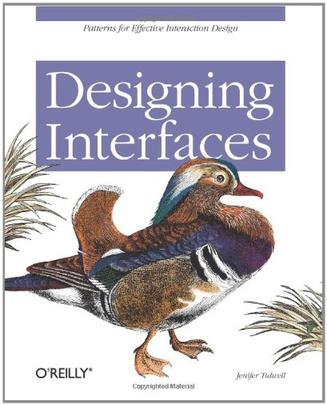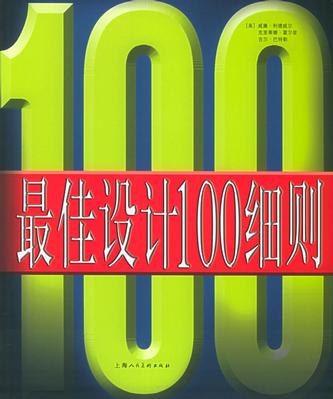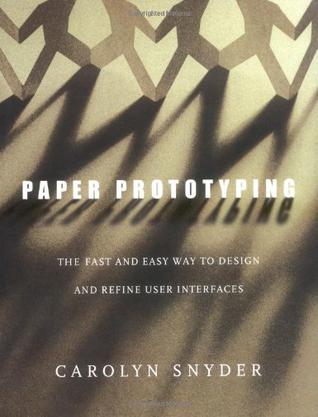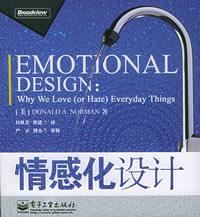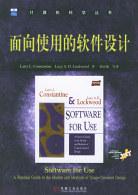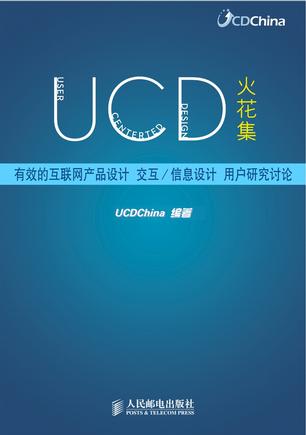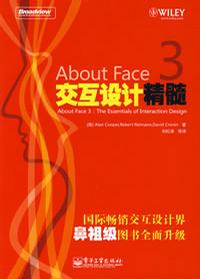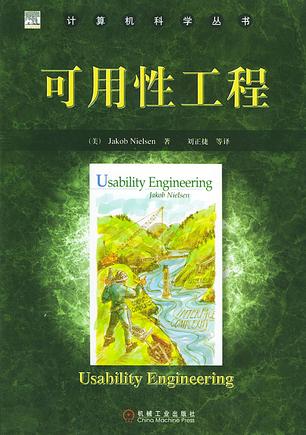欢迎来到相识电子书!
标签:UI
-
破茧成蝶:用户体验设计师的成长之路
市面上已经有很多专业的用户体验书籍,但解决用户体验设计师在职场中遇到的众多现实问题的图书并不多见。本书从用户体验设计师的角度出发,系统地介绍了其职业生涯中的学习方法、思维方式、工作流程等,覆盖了用户体验设计基础知识、设计师的角色和职业困惑、工作流程、需求分析、设计规划和设计标准、项目跟进和成果检验、设计师职业修养以及需要具备的意识等,力图帮助设计师解决在项目中遇到的一些常见问题,找到自己的职业成长之路。 本书由资深的一线用户体验设计师编写,书中融入了宝贵的职业经验和专业思考,对于交互设计师、视觉设计师、用户研究员等具有一定参考价值和借鉴意义;同时,本书也适用于产品经理、运营、开发等用户体验相关人员以及相关专业的学生阅读思考。 -
About Face 3:交互设计精髓
《About Face3交互设计精髓(经典再现软精装版)》是一本数字产品和系统的交互设计指南,全面系统地讲述了交互设计过程、原理和方法,涉及的产品和系统有个人计算机上的个人和商务软件、Web应用、手持设备、信息亭、数字医疗系统、数字工业系统等。运用《About Face3交互设计精髓(经典再现软精装版)》的交互设计过程和方法,有助于了解使用者和产品之间的交互行为,进而更好地设计出更具吸引力和更具市场竞争力的产品。 全书分成3篇:第1篇描述了“目标导向设计”,详细讨论了用户和设计的过程及思想;第2篇讲的是交互设计的原则,可以帮助您在较高层次上去把握设计;第3篇则介绍具体的细节方面的界面设计原则。 -
交互设计指南
本书对交互设计的来源和本质作了很好的介绍。书中包含了作者十多年来对交互设计的一些深刻理解,对如何做好交互设计有很强的实践价值。在本书第3~8章中,贯穿了一个能够广泛应用于各种项目的通用设计流程,能够帮助新手设计师按序将所有信息应用于实践。书中还有一些对交互设计领域的开创者和名人的访谈,可以让我们从多个角度对交互设计有一个深刻全面的认识。本书主要涉及数字产品如何工作的知识,不包含任何程序代码,基本与平台无关。 本书的针对对象既包括那些刚刚起步的新手设计师,也包括那些期望改进设计流程或增加设计工具的资深设计师。 “构建与人们进行交互的产品和服务是21世纪的重大挑战。Dan Saffer做了一项了不起的工作,他把凌乱的知识整理成了一本可理解的、有序的、任何想创建新设计的人必备的参考书。” ——Jared Spool,User Interface Engineering的CEO “《Designing for Interaction》是有见识的、智慧的和激动人心的。Dan Saffer 给当今的交互设计挑战提供了实用建议,并且针对未来的交互设计提出了明智见解。” ——Jesse James Garrett,《用户体验要素》的作者 -
人本界面
如果我们想克服目前人机界面上的固有缺陷,就很有必要理解本书的教义;若无此愿望,读读也无妨。交互设计的许多重要方面此书并没有包括在内,因为许多文献中都已经有详尽的阐述。本书的意图是补充现有的界面设计的方法或预测未来。 本书概述了人机界面设计领域的研究成果,详细论证了界面设计思想应以认知学为基础,并考虑人类的心智特点,在指出当前界面设计中弊端的同时,提出了新产品开发的思路。本书集计算机科学、人体工程学、心理学多种学科的内容于一身,是界面开发人员及相关研究者不可不读的一本好书。在本书中,我们可以看到“以人为本”已经不只是一种人机关系的理想,而是可以体现在界面以及相关软硬件技术上的具体设计原则和实现方法了。 -
Sketching User Experiences
Bill Buxton and I share a common belief that design leadership together with technical leadership drives innovation. Sketching, prototyping, and design are essential parts of the process we use to create new products. Bill Buxton brings design leadership and creativity to Microsoft. Through his thought-provoking personal examples he is inspiring others to better understand the role of design in their own companies--Bill Gates, Chairman, Microsoft "Informed design is essential." While it might seem that Bill Buxton is exaggerating or kidding with this bold assertion, neither is the case. In an impeccably argued and sumptuously illustrated book, design star Buxton convinces us that design simply must be integrated into the heart of business--Roger Martin, Dean, Rotman School of Management, University of Toronto Design is explained, with the means and manner for successes and failures illuminated by engaging stories, true examples and personal anecdotes. In Sketching User Experiences, Bill Buxton clarifies the processes and skills of design from sketching to experience modeling, in a lively and informative style that is rich with stories and full of his own heart and enthusiasm. At the start we are lost in mountain snows and northern seas, but by the end we are equipped with a deep understanding of the tools of creative design.--Bill Moggridge, Cofounder of IDEO and author of Designing Interactions "Like any secret society, the design community has its strange rituals and initiation procedures. Bill opens up the mysteries of the magical process of design, taking us through a land in which story-telling, orange squeezers, the Wizard of Oz, I-pods, avalanche avoidance, bicycle suspension sketching, and faking it are all points on the design pilgrim's journey. There are lots of ideas and techniques in this book to feed good design and transform the way we think about creating useful stuff". -Peter Gabriel I love this book. There are very few resources available that see across and through all of the disciplines involved in developing great experiences. This is complex stuff and Buxton's work is both informed and insightful. He shares the work in an intimate manner that engages the reader and you will find yourself nodding with agreement, and smiling at the poignant relevance of his examples.--Alistair Hamilton, Symbol Technologies, NY Books that have proposed bringing design into HCI are aplenty, though books that propose bringing software in to Design less common. Nevertheless, Bill manages to skilfully steer a course between the excesses of the two approaches and offers something truly in-between. It could be a real boon to the innovation business by bringing the best of both worlds: design and HCI. --Richard Harper, Microsoft Research, Cambridge There is almost a fervor in the way that new products, with their rich and dynamic interfaces, are being released to the public-typically promising to make lives easier, solve the most difficult of problems, and maybe even make the world a better place. The reality is that few survive, much less deliver on their promise. The folly? An absence of design, and an over-reliance on technology alone as the solution. We need design. But design as described here depends on different skillsets-each essential, but on their own, none sufficient. In this rich ecology, designers are faced with new challenges-challenges that build on, rather than replace, existing skills and practice. Sketching User Experiences approaches design and design thinking as something distinct that needs to be better understood-by both designers and the people with whom they need to work- in order to achieve success with new products and systems. So while the focus is on design, the approach is holistic. Hence, the book speaks to designers, usability specialists, the HCI community, product managers, and business executives. There is an emphasis on balancing the back-end concern with usability and engineering excellence (getting the design right) with an up-front investment in sketching and ideation (getting the right design). Overall, the objective is to build the notion of informed design: molding emerging technology into a form that serves our society and reflects its values. Grounded in both practice and scientific research, Bill Buxton's engaging work aims to spark the imagination while encouraging the use of new techniques, breathing new life into user experience design. . Covers sketching and early prototyping design methods suitable for dynamic product capabilities: cell phones that communicate with each other and other embedded systems, "smart" appliances, and things you only imagine in your dreams; . Thorough coverage of the design sketching method which helps easily build experience prototypes-without the effort of engineering prototypes which are difficult to abandon; . Reaches out to a range of designers, including user interface designers, industrial designers, software engineers, usability engineers, product managers, and others; . Full of case studies, examples, exercises, and projects, and access to video clips (www.mkp.com/sketching) that demonstrate the principles and methods. About the Author Trained as a musician, Bill Buxton began using computers over thirty years ago in his art. This early experience, both in the studio an on stage, helped develop a deep appreciation of both the positive and negative aspects of technology and its impact. This increasingly drew him into both design and research, with a very strong emphasis on interaction and the human aspects of technology. He first came to prominence for his work at the University of Toronto on digital musical instruments and the novel interfaces that they employed. This work in the late 70s gained the attention of Xerox PARC, where Buxton participated in pioneering work in collaborative work, interaction techniques and ubiquitous computing. He then went on to become Chief Scientist of SGI and Alias|Wavefront, where he had the opportunity to work with some of the top film makers and industrial designers in the world. He is now a principal researcher at Microsoft Corp., where he splits his time between research and helping make design a fundamental pillar of the corporate culture. * Covers sketching and early prototyping design methods suitable for dynamic product capabilities: cell phones that communicate with each other and other embedded systems, "smart" appliances, and things you only imagine in your dreams; * Thorough coverage of the design sketching method which helps easily build experience prototypes-without the effort of engineering prototypes which are difficult to abandon; * Reaches out to a range of designers, including user interface designers, industrial designers, software engineers, usability engineers, product managers, and others; * Full of case studies, examples, exercises, and projects, and access to video clips that demonstrate the principles and methods. -
瞬间之美
本书特色: 本书通过重现用户面对Web应用时由始至终的完整情境,主要针对Web应用中几乎所有相关元素,例如Search、Screencast、Blog 、Wizard、 RSS、 Rate 、TagCloud 以及Form的布局、交互甚至客服等都提出了值得借鉴的解决方案。具体通过30多个故事轻松自然地带领读者领会设计者如何百分之百地用心传达以创造美好的用户体验。 本书适用于信息架构设计师、交互设计师、Web开发人员使用 ,资深设计师可将本书用做汇集了设计方法和思路的参考手册。初级设计师以及Web开发人员则可以按照书中的方法直接使用,找到一条通往用户体验设计的捷径。 业界评论: 1. 译者评论: 翻译这本书其实也是一个学习的过程。乍看上去似乎书里面没什么很新的理论或者概念,但是作者有一种“大拙若巧、顺其自然”的味道,每一个问题点(也就是书中的一个个故事)最后的解决方案都是千锤百炼的结晶。也就是说,如果你不了解UE,只需按他所说的去做就保准没事;如果你有过研究,那么每个方案背后的方法和思路同样值得学习。它是一本好书,值得我向任何人推荐 2.专业人士评论: 严格来说这不是一本告诉你从头到尾如何设计Web的书,这一点真是太棒了。我们并不需要某人彻头彻尾地驯服我们的方法、我们的原则、以及我们的个性。然而它却是一本激发我们百分之百用心地与用户交流和思考的好书。书中你见不到一行HTML/Javascript/Perl/PHP/Ruby技术代码,作者完全根据自己的亲身经历和设计经验简单直接地告诉我们良好的用户体验,全在于那些完美的“瞬间”。这是一本激发Web设计灵感的枕边小册,值得我们经常翻阅。 -
交互设计沉思录
本书由交互设计领域的思想领袖Jon Kolko所著,是交互设计领域的里程碑之作。本书完美地将当代设计理论和研究成果融入交互设计实践中,将对交互设计的阐释和分析推向了新的高度。本书重点阐释了对交互设计领域的最新理解和洞察,以及人与科技之间的联系。作者通过引人入胜的内容实现对设计师的教化,帮助设计师教化商业人士,同时确立交互设计在商业领域中的地位。本书不但探讨了经济局面的变化、互联性的增强和全球化的科技普及如何影响针对人类行为的设计活动和设计本身,而且对交互设计的定义进行了更好地阐释,主要涵盖三个方面:其一,交互设计涉及的各个知识层面;其二,交互设计作为“以人为本”的学科所包含的基本概念;其三,交互设计师在实践当中获得的经验和采用的方法与手段。此外,本书还讨论了(设计)语言、观点和话术在产品、服务和系统的设计当中所扮演的角色,并介绍了交互设计师处理关乎行为和时间的复杂问题的过程,该过程包括构造大量的数据、考察用户、尝试为随时间不断演化的人类行为提供支持等。 -
关键设计报告
《关键设计报告:改变过去影响未来的交互设计法则》讲述了交互设计所有最基本的东西:交互设计的发展历史和由来,交互设计领域里的关键人物,交互设计的基本原则和方法和交互设计的著名案例。尤其有价值的是在第十章里面介绍了IDEO 的创新方法卡片和IDEO做交互设计的过程。 数码技术与网络应用家喻户晓,无所不在。《关键设计报告:改变过去影响未来的交互设计法则》从我们朝夕相伴、不足为奇的设计,到尚未体验并涉足的设计,从鼠标操作模式的设计,到台式电脑界面的设计、笔记本电脑的诞生、掌上电脑的成功问世、平板电脑的笔与纸、数码相机的互动模式、进入电玩游戏的角色扮演、i-mode吸引日本1/4的人注册手机、Google如何占领了网上搜索引擎、iPod横扫全球的设计秘密……可谓一部尚未完成的交互设计史。 书中收录了那些影响人类近四十年生活的42位交互设计师的精彩访谈,他们在这个领域的工作改变了人们工作和娱乐的方式,收录了交互设计史上的经典案例:笔记本电脑的发明、鼠标操作模式改进、掌上电脑的成功问世、amazon界面对网络购物的冲击、i-mode攻下日本手机市场、Google界面的如何占领了网络世界、iPod横扫全球的设计秘密……把对用户的关注,创新设计以及出色的领导能力和产品的成功建立了因果联系。 -
Web表单设计
精心设计的表单,能让用户感到心情舒畅,愉快地注册、付款和进行内容创建和管理,这是促成网上商业成功的秘密武器。本书通过独到、深邃的见解,丰富、真实的实例,道出了表单设计的真谛。新手设计师通过阅读本书,可广泛接触到优秀表单设计的所有构成要素。经验丰富的资深设计师,可深入地了解以前没有注意到的问题及解决方案。 本书专为表单设计或开发人员准备,但同时也适合可用性工程师、网站开发人员、产品经理、视觉设计师、交互设计师、信息架构人员以及任何一个涉及表单与调查问卷设计的人员阅读和参考。 -
交互设计之路
本书是基于众多商务案例,讲述如何创建更好的、高客户忠诚度的软件产品和基于软件的高科技产品的书。本书列举了很多真实可信的实际例子,说明目前在软件产品和基于软件的高科技产品中,普遍存在着“难用”的问题。作者认为,“难用”问题是由这些产品中存在着的高度“认知摩擦”引起的,而产生这个问题的根源在于现今软件开发过程中欠缺了一个为用户利益着想的前期“交互设计”阶段。“难用”的产品不仅损害了用户的利益,最终也将导致企业的失败。本书通过一些生动的实例,让人信服地讲述了由作者倡导的“目标导向”交互设计方法在解决“难用”问题方面的有效性,证实了只有改变现有观念,才能有效地在开发过程中引入交互设计,将产品的设计引向成功。 本书虽然是一本面向商务人员而编写的书,但也适合于所有参与软件产品和基于软件的高科技产品开发的专业人士,以及关心软件行业和高科技行业现状与发展的人士阅读。 -
Designing Interfaces
Designing a good interface isn't easy. Users demand software that is well-behaved, good-looking, and easy to use. Your clients or managers demand originality and a short time to market. Your UI technology -- Web applications, desktop software, even mobile devices - may give you the tools you need, but little guidance on how to use them well. UI designers over the years have refined the art of interface design, evolving many best practices and reusable ideas. If you learn these, and understand why the best user interfaces work so well, you too can design engaging and usable interfaces with less guesswork and more confidence. "Designing Interfaces" captures those best practices as design patterns - solutions to common design problems, tailored to the situation at hand. Each pattern contains practical advice that you can put to use immediately, plus a variety of examples illustrated in full color. You'll get recommendations, design alternatives, and warnings on when not to use them. Each chapter's introduction describes key design concepts that are often misunderstood, such as affordances, visual hierarchy, navigational distance, and the use of color. These give you a deeper understanding of why the patterns work, and how to apply them with more insight. A book can't design an interface for you - no foolproof design process is given here - but "Designing Interfaces" does give you concrete ideas that you can mix and recombine as you see fit. Experienced designers can use it as a sourcebook of ideas. Novice designers will find a roadmap to the world of interface and interaction design, with enough guidance to start using these patterns immediately. -
最佳设计100细则
本书按字母顺序编排,查阅方便,能迅速根据名称检索设计原则。对于有兴趣解决具体问题的读者,本书根据设计师常见的问题给通则作了分类。每一个原则均用双页的版式呈现。左手页包含原则简明的定义、详尽的描述、运用的例子以及运用的准则,文本的右侧有边注,提供详尽的说明和参考书目。右手页包含直观的实例和相关的图形,使读者对设计原则有更深的理解。 完美的设计不只属于少数才华出众的人士,其实几乎所有设计师都能在设计上臻于完美。使用公认的设计原则能增加成功设计的概率。使用《最佳设计1 OO细则》,把它作为增加跨学科知识和增强设计理解力的手段,能促发奇想,找到解决设计问题的方法,更新不常使用的设计原则的记忆。最后,还可把本书用作检查设计过程和作品质量的手段。 -
面向使用的软件设计
面向使用的软件设计,ISBN:9787111140580,作者:Larry L.Constantine,Lucy A.D.Lockwood著;刘正捷等译;刘正捷译 -
UCD火花集
本书收集了UCDChina上线以来推出的13个话题,内容涵盖了产品设计的全部流程,按顺序集结到第一到第十三章中,讨论了如何研究用户、如何将用户需求应用到产品设计中、如何传达和协作。在第十四章,几位设计师分享了生活中的UE故事。第十五章,列举了一些实例和实践者的观点。本书适合有一定工作经验,从事产品设计、产品策划、交互设计、视觉设计、用户研究、前端开发、网站运营,以及所有与互联网有关的从业人员阅读。 -
About Face 3 交互设计精髓
本书是一本数字产品和系统的交互设计指南,全面系统地讲述了交互设计过程、原理和方法,涉及的产品和系统有个人电脑上的个人和商务软件、Web应用、手持设备、信息亭、数字医疗系统、数字工业系统等。运用本书的交互设计过程和方法,有助于了解使用者和产品之间的交互行为,进而更好地设计出更具吸引力和更具市场竞争力的产品。 全书分成3篇:第1篇描述了“目标导向设计”,详细讨论了用户和设计的过程及思想;第2篇讲的是交互设计的原则,可以帮助您在较高层次上去把握设计;第3篇则介绍具体的细节方面的界面设计原则。 本书结构清晰、深入浅出,是一本难得的大师经典之作。本书的读者对象包括数字产品和系统的交互设计师、用户界面设计师、项目经理、可用性工程师等,以及目前正在学习交互设计和用户界面设计专业的本科和研究生等。 -
可用性工程
《可用性工程》系统地介绍可用性工程,被国际可用性工程界一致推崇为该领域的最佳入门书籍。《可用性工程》着重讲述了能取得良好成本效益的可用性方法,并详细介绍了在软件开发生命周期的不同阶段如何运用这些方法,以及其他与可用性相关的特殊问题。
热门标签
下载排行榜
- 1 梦的解析:最佳译本
- 2 李鸿章全传
- 3 淡定的智慧
- 4 心理操控术
- 5 哈佛口才课
- 6 俗世奇人
- 7 日瓦戈医生
- 8 笑死你的逻辑学
- 9 历史老师没教过的历史
- 10 1分钟和陌生人成为朋友

